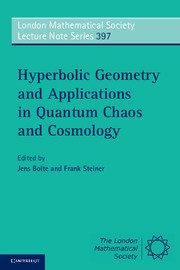Book contents
- Frontmatter
- Contents
- List of Contributors
- Preface
- I Hyperbolic Geometry
- II Selberg's Trace Formula: An Introduction
- III Semiclassical Approach to Spectral Correlation Functions
- IV Transfer Operators, the Selberg Zeta Function and the Lewis-Zagier Theory of Period Functions
- V On the Calculation of Maass Cusp Forms
- VI Maass Waveforms on (Γ0(N), χ) (Computational Aspects)
- VII Numerical Computation of Maass Waveforms and an Application to Cosmology
- Index
- References
II - Selberg's Trace Formula: An Introduction
Published online by Cambridge University Press: 05 January 2012
- Frontmatter
- Contents
- List of Contributors
- Preface
- I Hyperbolic Geometry
- II Selberg's Trace Formula: An Introduction
- III Semiclassical Approach to Spectral Correlation Functions
- IV Transfer Operators, the Selberg Zeta Function and the Lewis-Zagier Theory of Period Functions
- V On the Calculation of Maass Cusp Forms
- VI Maass Waveforms on (Γ0(N), χ) (Computational Aspects)
- VII Numerical Computation of Maass Waveforms and an Application to Cosmology
- Index
- References
Summary
The aim of this short lecture course is to develop Selberg's trace formula for a compact hyperbolic surface M, and discuss some of its applications. The main motivation for our studies is quantum chaos: the Laplace-Beltrami operator –Δ on the surface M represents the quantum Hamiltonian of a particle, whose classical dynamics is governed by the (strongly chaotic) geodesic flow on the unit tangent bundle of M. The trace formula is currently the only available tool to analyze the fine structure of the spectrum of –Δ; no individual formulas for its eigenvalues are known. In the case of more general quantum systems, the role of Selberg's formula is taken over by the semiclassical Gutzwiller trace formula [11], [7].
We begin by reviewing the trace formulas for the simplest compact manifolds, the circle S1 (Section 1) and the sphere S2 (Section 2). In both cases, the corresponding geodesic flow is integrable, and the trace formula is a consequence of the Poisson summation formula. In the remaining sections we shall discuss the following topics: the Laplacian on the hyperbolic plane and isometries (Section 3); Green's functions (Section 4); Selberg's point pair invariants (Section 5); The ghost of the sphere (Section 6); Linear operators on hyperbolic surfaces (Section 7); A trace formula for hyperbolic cylinders and poles of the scattering matrix (Section 8); Back to general hyperbolic surfaces (Section 9); The spectrum of a compact surface, Selberg's pre-trace and trace formulas (Section 10); Heat kernel and Weyl's law (Section 11); Density of closed geodesics (Section 12); Trace of the resolvent (Section 13); Selberg's zeta function (Section 14); Suggestions for exercises and further reading (Section 15).
- Type
- Chapter
- Information
- Publisher: Cambridge University PressPrint publication year: 2011
References
- 15
- Cited by

